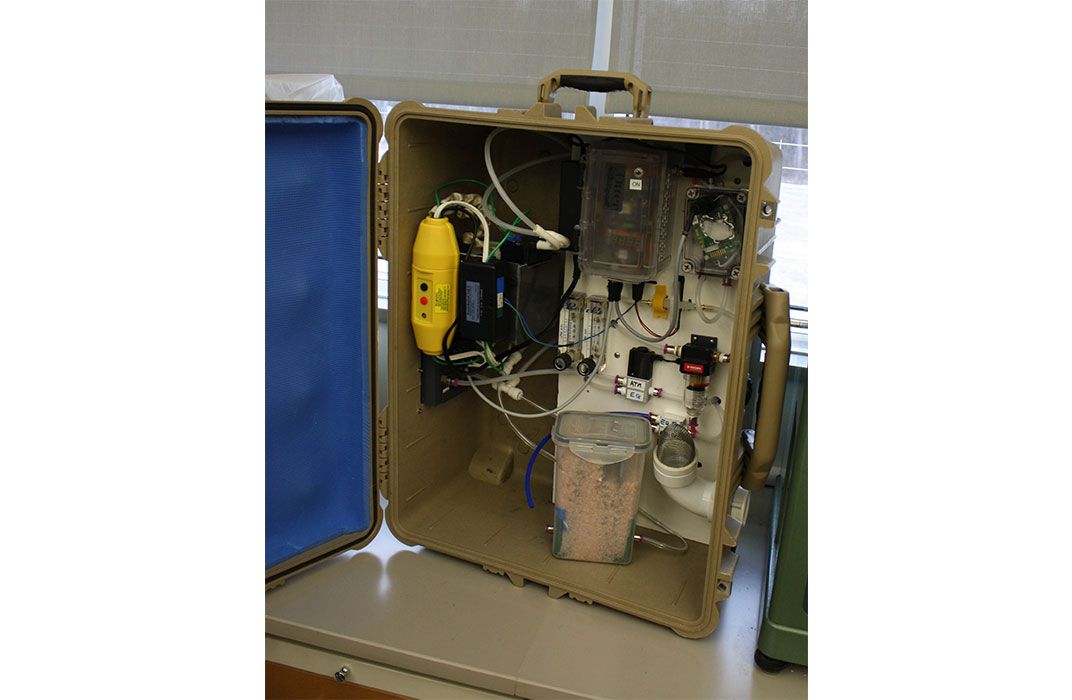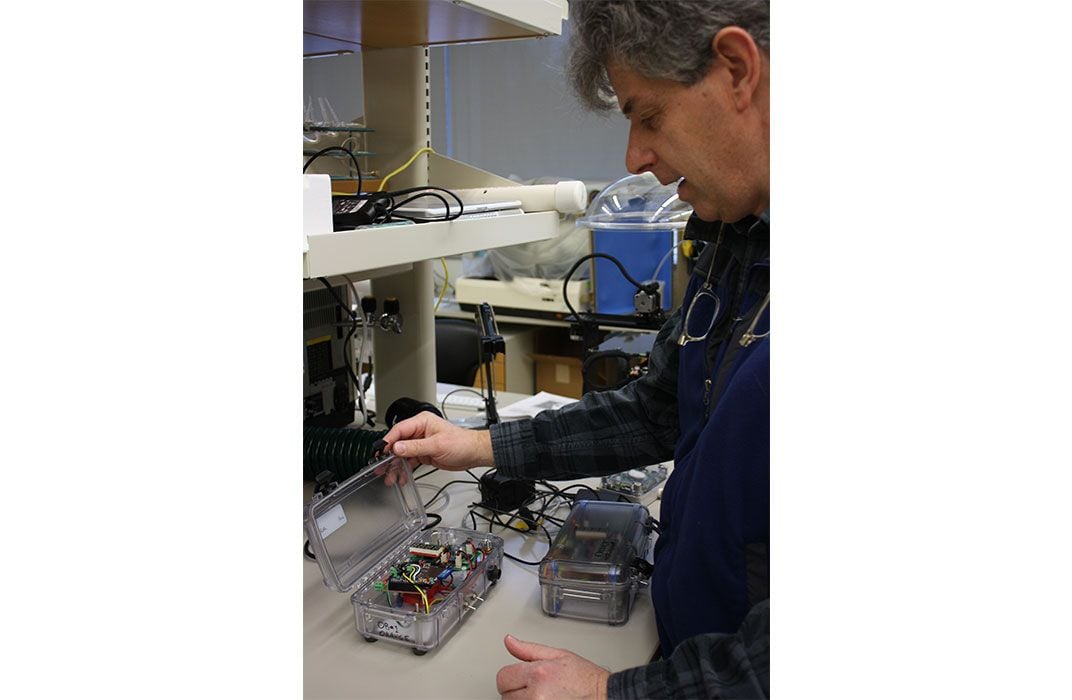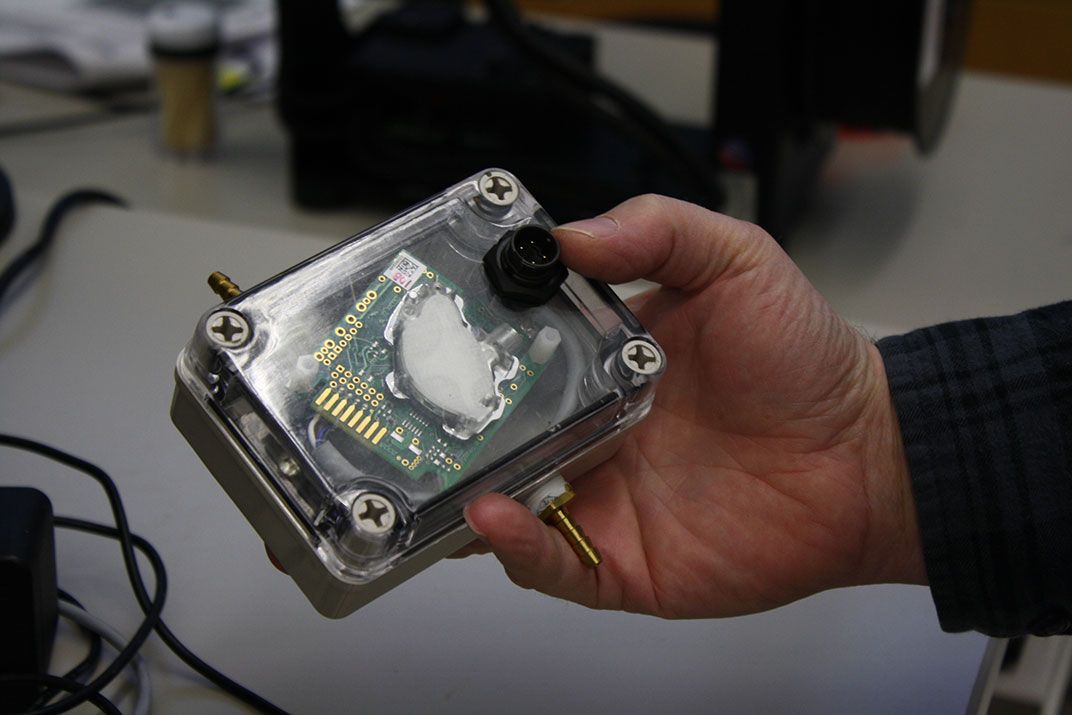Saving Money is Great, but Saving the Chesapeake Bay Will Be Even Better
Whitman Miller’s “off the shelf” technology may answer complicated questions about rising CO2 and ocean acidification
:focal(566x137:567x138)/https://tf-cmsv2-smithsonianmag-media.s3.amazonaws.com/filer/3e/9e/3e9e21b1-6ff8-4ad0-b511-22f0eb52aa8e/2nd-option-on-the-dock_9797web.jpg)
It could be mistaken for a science fair project gone amok—a suitcase-sized water proof box stuffed with tubing, electronic wires, gauges and an LED display. To Whitman Miller, that’s the beauty of it. Everything is easily available, relatively inexpensive and remarkably sophisticated. He needs that combination of qualities. Because to get the answers he’s looking for, he’ll have to install lots and lots of these boxes.
Miller is a researcher at the Smithsonian Environmental Research Center, and he is trying to understand the effects of rising CO2 on water chemistry in coastal ecosystems. For the last 150 years the burning of fossil fuel and other industrial manufacturing processes has pumped vast quantities of CO2 into the atmosphere. Much of it has ended up in the Earth’s oceans where it reacts with seawater and lowers pH. As a result, Earth’s waters are becoming more acidic, a condition that may strip many shelled organisms of their calcium and threaten to disrupt entire ecosystems.
Although most often referred to as ocean acidification, the effect of rising CO2 is not restricted to ocean waters. It’s just easier to see there. The ocean surface is a fairly homogenous environment where CO2 concentrations in the water tend to be in equilibrium with CO2 in the atmosphere—currently around 399.6 parts per million (ppm). Scientists have been watching it creep up steadily at a rate of 1 ppm every year for the past few decades.
But the story is not so easy to read in coastal ecosystems where CO2 concentrations can swing by thousands of parts per million in a single day. Coastal systems are far more complex with many more moving parts. Here, fresh water mixes with salt water. Temperature and salinity vary from one location to the next and can change with the tides. Oxygen levels rise during the day, when grasses and algae photosynthesize, and crash at night when photosynthesis stops. All of these interactions drive dramatic fluctuation in CO2 levels. They also vary from one location to the next and on a daily basis. Understanding how a comparatively small increase in global CO2 will affect a system with so much natural fluctuation means learning exactly how that system works.

“We’re trying to tease out many of these different drivers,” Miller says. “Because we know it’s not just air-sea equilibrium. We know there are land sea interfaces. We know there are biological effects of photosynthesis and respiration, and physical effects of water input in different places. But to tease out each of these drivers, we’re learning that we need lots and lots of measurements. We need a high density of measurements because of this special patchiness and because of the way it changes through time on daily, seasonal and tidal scales.”
Miller needs a network of monitoring stations to gather that level of data, a network that wasn’t practical when he began this work. The monitoring instrumentation required was the stuff of ocean buoys and big research vessels costing tens of thousands of dollars per instrument.
So Miller began developing another option. He's been building his own portable, inexpensive monitoring stations with readily available electronic components and an inexpensive microcontroller of the kind hobbyists use to make robots and motion detectors. What he’s come up with is the difference between a small room full of equipment ringing in at $100,000, and a suitcase-sized box for the price of a high-end home weather station.
Inside that box, Miller has packed barometric pressure sensors, temperature sensors, relative humidity sensors, and of course, a CO2 sensor. “This guy here costs less than $300,” he says, pointing to a square of electronics no bigger than a deck of cards. “The infra-red gas analyzer—this is the heart of making the CO2 measurement itself.” He says the corollary instrument on an ocean buoy could cost as much as $20,000.

Outside the box, on the “wet side,” water is pumped through a tube and forced into equilibrium with a small volume of air. The gas analyzer determines the concentration of CO2 in that air, and a data logger keeps track 24/7.
“This is an innovative approach,” says Mario Tamburr, “to look at a simple inexpensive way of getting these measurements.” Tamburri is a research professor at the University of Maryland Center for Environmental Sciences (UMCES). “Our biggest problem now is being able to monitor these important parameters at the right temporal and spatial scale. So these kinds of high temporal and spatial resolution measurements are key to understanding the problems of acidification, especially in coastal waters.”
Tamburri is also the executive director of the Alliance for Coastal Technologies, a partnership between research organizations that serves as a kind of testing lab for scientific equipment. “One of the things we try to do is to foster the development and adoption of new innovations.” He’s been running one of Miller’s monitoring stations from the pier at UMCES for a year “to demonstrate its capabilities and potential so other users can then also have some confidence in adopting it.”
Currently there are three other CO2 monitoring stations in operation. One at the Smithsonian Environmental Research Center in Edgewater where Miller works, one at the Smithsonian Marine Station at Fort Pierce, Florida, and another at the Smithsonian Tropical Research Institute in Panama. Miller’s not yet ready to begin mass producing his instruments yet. He has a few more tweaks before he can begin developing a network of monitoring sites throughout the Chesapeake Bay. He’s working on replacing the pump with one that draws less power, preferably one that runs on solar power. And he’s hoping to reduce the price even further (one station now costs about $7,000). Eventually he hopes to enlist citizen scientists, volunteers willing to keep them at their private piers.
“My gold standard for an instrument is that you be able to turn it over to a citizen scientist,” he says, “and for them to be able to care for it, and run it, and develop the data. It has to be something that somebody who doesn’t have years and years of education using instruments can make it function.”
That’s what it’s going to take to get the kind of measurements needed to truly understand the role of rising CO2 in these complex systems.
